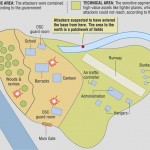IDR Blog
Needed a Vajpayee template to resolve Kashmir
The bugle for the 2019 national election has been sounded by the Bharatiya Janata Party (BJP) through its decision to pull out of an uneasy and prickly alliance it had forged with the People’s Democratic Party (PDP ) in Srinagar. The BJP with its right-wing Hindu orientation clearly wishes to sever links with a regional party deemed to be ‘soft’ towards the separatist constituency in the Muslim dominated Kashmir valley and position itself at the hustings as the guardian of India’s territorial integrity and security interests.
The resignation by Jammu & Kashmir Chief Minister Mehbooba Mufti (June 19) brings to an abrupt end a very unlikely and what has been described as an ‘unholy’ alliance between two ideologically divergent political parties. Governor’s rule has been imposed and the speculation that a new incumbent may be appointed, since the tenure of the current Governor N N Vohra (appointed in 2008) will end on June 25 has been laid to rest. It is unlikely that any changes will take place before the annual Amarnath yatra (pilgrimage) which concludes in end August.
What was the trigger for this sudden but not unexpected decision and what does this mean for the state of J&K over the next year ? The BJP has justified its decision to pull out of the ruling alliance in Srinagar citing “the larger national interest” and ‘ the deteriorating security situation” and a determination that Governor’s rule was necessary to bring this under control. The most recent killing of senior editor Shujaat Bukhari in Srinagar and Indian Army soldier Aurangazeb on the eve of Eid by terrorists is case in point.
The expectation is that without being constrained by political compulsions, the security forces in J&K which include the army, central armed police forces (CAPF) and local police will be able to adopt a more muscular and robust approach to bring the situation under control. Official figures indicate that terror incidents in J&K shot up from 20 in mid April to May ; and that in the subsequent period May 17 to June 16, this figure has gone up to 73. The number of terrorists killed also went up from 14 to 22 in these two periods and more significantly, many of those neutralized were foreign fighters.
The macro assessment of the security situation in J&K points to a pre and post Burhan Wani pattern, wherein after the elimination of the young terrorist leader in July 2016, the level of internal violence and discord steadily increased. Stone pelting against local security forces aggravated the situation and this was compounded by the Kathua rape incident in January this year. Support to terror and militant attacks was also reflected in the cross-border violations / firing incidents that spiked from a total of 449 in 2016 to 971 in 2017 ; and in this year, even before the six-month period has ended, the figure is 633.
Against this backdrop, Mehbooba Mufti reiterated at her post resignation press-meet that her PDP-led government had done “everything that we could” to manage the situation and highlighted the month-long Ramzan cessation of combat operations as an indicator of the PDP’s commitment to the path of political accommodation and reconciliation. It is evident that her coalition partner , the local BJP did not subscribe to what was seen as an appeasement of the terrorist-separatist factions . While the BJP pulling out of the alliance was inevitable, Mufti cautioned that a “muscular policy will never work and the only way forward is our healing touch policy.” And in a very significant statement that subtly pointed to the inherent political dissonance between the PDP and the BJP, she added: “Kashmir is not an enemy territory.”
The BJP decision to pull out of the ruling coalition in Srinagar was driven to a large extent by the political dynamic of the next general election in 2019. The party leadership wanted to shed the contradiction of a Hindu right wing party being politically aligned to a regional party whose constituency is largely confined to the Muslim dominated Kashmir valley. This has been achieved and preliminary reports suggest that the local BJP cadres in the state of J&K have finally obtained ‘azadi’ from a stifling political alliance with the Mufti-led PDP.
The complexity of the J&K issue goes back to August-October 1947 and has become even more tangled with every passing year. India and Pakistan are the principal interlocutors and since the mid 1960’s, China has also been brought into the picture. Pakistan, it may be recalled illegally ceded some territory of the composite J&K state to China in 1963.
The forced expulsion of the local Hindu community in early 1990 and the progressive introduction of a militant religious element has now morphed into ruthless terrorism that opposes moderation, dialogue and political accommodation. The silencing of local leaders like Abdul Ghani Lone (2002) and now the Bukhari killing is the new reality that Delhi has to contend with under Governor’s rule.
This is not the first time that J&K has faced such a situation and this will be the eighth time since 1977 that Governor’s rule is being imposed in Srinagar and the fourth time since Vohra assumed office in June 2008. While such an arrangement where Delhi is in control may help to redress a deteriorating security situation, it is accepted that a more sustainable and equitable management of the J&K issue has to be multi-dimensional. Many tracks/policies have to be pursued with different interlocutors and constituencies, with the focus being on the human security of the local people.
The political tracks that need to be irrigated are Delhi-Srinagar ; Delhi-Islamabad ; Srinagar-Muzaffarabad and Delhi-Beijing at the government level. The Rawalpindi-Muridke axis which links the Pakistan Army GHQ with the terror groups such as the Lashkar-e-Taiba will have to be weakened. These initiatives have to be complemented by the long drawn out socio-political process, wherein decades of alienation, mistrust, religious polarization and the trauma of terror in J&K have to be redressed. This is not a task that can be done by executive fiat from Delhi or Srinagar and the local political parties have to be involved.
A political consensus among the regional J&K entities and the major national parties about the current status and future contour of J&K is imperative. Issues such as the status of Article 370 of the Constitution and the finality of the accession of the composite state of J&K in the Indian Union, even while acknowledging and respecting the constitutional provisions distinctive to Srinagar, have to be addressed. Neither Pakistan nor China can be wished away from the dialogue process and even if the trilateral framework (tentatively suggested by the Chinese ambassador) is a non-starter, Delhi has to review its policy options in a holistic manner.
J&K has experienced many dark phases and the summer of 1990 when Pakistan fished in troubled waters merits recall. Much water has flown in the troubled state since then – over 50,000 lives have been lost – and today the environment has to contend with social media, fake news, misplaced youth fervor and a distorted invocation of religion.
Past policy errors have to be avoided. The current phase of Governor / President’s rule must be utilized to create the enabling eco-system that will allow the realization of the (former Prime Minister ) Vajpayee template made in a speech in Srinagar in 2013 – ‘ insaniyat-jamooriyat-kashmiriyat’ (Humanism-Democracy-Kashmiri’s plural ethos). The world’s largest democracy has to remain wedded to the liberal principle in dealing with its own citizens – however alienated and angry they may be with past omissions and excesses.
Courtesy: https://southasiamonitor.org/news/needed-a-vajpayee-template-to-resolve-kashmir/sl/27431




